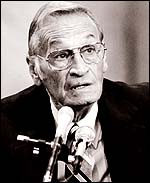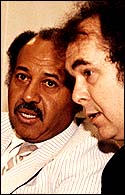

| ||
 |
Harry E. Claiborne of the United States District Court in Nevada accepted two bribes of $55,000, paid to influence his rulings. |
 |

n the cases of the three federal judges impeached and removed by the Senate in the last 60 years, the common thread is the egregious misconduct these former jurists displayed before they were finally disciplined. And just behind this lies uneasy awareness within the system that serious misconduct which may fall short of these spectacular incidents goes unexposed and unaddressed.
In the early 1980s, Harry E. Claiborne of the United States District Court in Nevada accepted two bribes of $55,000, paid to influence his rulings. He was tried, convicted and sent to federal prison for intentionally falsifying his income tax returns.
But Claiborne refused to step down as a federal judge, even while languishing in the penitentiary. He contended that he had been the victim of “base tactics.” Friends and colleagues implored him to resign, to spare further embarrassment to the judiciary and to his family and to avoid the necessity of embroiling the U.S. Senate, the only body that could legally remove him.
Claiborne was unmoved. He was ultimately tried and convicted by the Senate, resulting in his removal as a judge in 1986.
Also in the early 1980s, Walter Nixon of District Court in Mississippi was charged with receiving bribes while on the bench and then lying under oath before the grand jury later convened to investigate. He claimed to have had no connection with the cases involving the alleged bribes, yet it was conclusively proven otherwise.

|
 |
|
| Alcee Hastings (left), removed as a federal judge by the U.S. Senate in 1988 for 17 acts of corruption which “strike at the heart of our democracy,” today holds a seat in Congress. | ||
He was charged with and convicted of two counts of perjury by a federal jury. But he remained on the bench, a free man despite conviction.
Finally, in 1989, his case went to a Senate trial and resulted in his removal as a judge.
Perhaps the story of Alcee Hastings, once a District Court judge in Florida, most pointedly embodies the need for the reform — and upgrade — of current thoroughly inadequate disciplinary procedures.
The saga began with attorney William Borders Jr., a rising star in the Washington legal community, who became involved with a felony case in Florida involving two brothers, Frank and Tom Romano. The Romanos had been convicted in 1980 of taking $1.2 million from a Teamsters’ pension fund. In early 1981, Hastings, as the judge presiding over the case, ordered seizure of $1.2 million of the Romanos’ assets, including $845,000 in cash. At the time Borders became involved, a final judgment on that forfeiture was pending.
By April 1981, Borders had developed a scheme to solicit a bribe for Hastings from Frank Romano, in exchange for ensuring that the majority of the Romanos’ seized property was returned to them.
Investigators established a pattern of phone calls between Hastings and Borders from February to October 1981, generally corresponding to dates when Hastings was engaged in some kind of action or hearings on the Romanos’ legal situation.
A central piece of evidence in later proceedings came through an FBI tape recording of a phone conversation between Hastings and Borders on October 5, 1981 — the same day that Hastings told his clerk to immediately prepare the order releasing the Romanos’ property. The transcript, according to the presentation by government prosecutors, shows the two speaking in code — Borders telling Hastings that he had received the $25,000 intended for him, Hastings telling Borders that he would issue the order releasing the property forthwith. Borders was arrested in October 1981, when he accepted the remaining $125,000 of the bribe during an FBI sting. He was tried and convicted in 1982 and sentenced to five years in prison and $35,000 in fines.
The trail of evidence led to criminal charges against Hastings, too. He stood trial but was acquitted. In December 1982, however, Judge Frank M. Johnson wrote an opinion for the 11th Circuit Court of Appeals which upheld Borders’ conviction — and also found that the jury in the Borders case had sufficient evidence to conclude “beyond any reasonable doubt that Judge Hastings was a member of such a conspiracy.”
Even his peers could no longer ignore Hastings’ situation. This and other evidence led to Chief Judge William Terrell Hodges of the U.S. District Court for the Middle District of Florida and Chief Judge Anthony A. Alaimo of the U.S. District Court for the Southern District of Florida — Hastings’ own court — to file a complaint against Hastings under the Code of Judicial Conduct’s requirement that judges who become aware of unprofessional judicial conduct by other judges make it known.
The final report issued by the five-judge committee appointed to investigate the charges concluded that at his trial, Hastings had fabricated documents submitted as evidence and committed perjury 14 times. The report concluded, “Judge Hastings attempted to corruptly use his office for personal gain. [The committee found] clear and convincing evidence that Judge Hastings sought to conceal his participation in the bribery scheme.... Judge Hastings’ conduct was premeditated, deliberate and contrived.”
The committee reported to the 11th Circuit Judicial Council, which voted unanimously to support the conclusion that grounds to recommend impeachment indeed existed. The same procedure was then followed by the Judicial Conference of the United States, over which the Chief Justice presides, and that body unanimously voted for impeachment. The matter was then sent to the U.S. House of Representatives.
Incredibly, through the entire process to that stage, not a single disciplinary action had been imposed on Hastings, who still sat as a federal district judge.
The House Judiciary committee, after investigation, recommended impeachment.
For the next six years, Hastings remained on the bench, using federal court facilities and drawing a full salary while hearing virtually no cases because of his tenuous position and the refusal of the Chief Justice of his district to assign cases to him.
Finally, in 1988, the House charged Hastings, by a 413 to 3 vote, with 17 acts of misconduct which “strike at the heart of our democracy,” and recommended removal by the Senate. The Senate agreed, and in 1989 found Hastings guilty of eight impeachable offenses, including conspiring as a federal judge to obtain a $150,000 bribe.
Hastings was finally out. As a judge. But there is an epilogue to this saga: As he appealed his ouster to the U.S. District Court for the District of Columbia, he set his sights on elected office.
He ran unsuccessfully for governor of Florida. Then, after reapportionment mandated by the Voting Rights Act, Hastings saw a chance to try again, this time for Congress, in a newly formed district.
During his 1992 congressional campaign, his primary opponent repeatedly raised the issue of his removal from the bench. But his candidacy got a boost when a U.S. District Judge in Washington, D.C., overturned Hastings’ removal by the Senate on a technicality — and Hastings was elected to the House of Representatives in November 1992.
Then, in January 1993, just as Hastings was being sworn in as a congressman, the U.S. Supreme Court reversed the district court’s ruling and Hastings’ conviction was effectively reinstated.
Yet, Congressman Hastings he remains. He insists that the impeachment law can be interpreted to allow him to retain his congressional seat, even though his removal as a federal judge included a prohibition from “hold[ing] and enjoy[ing] any office of honor, trust or profit under the United States.” Hastings contends that because the Senate did not expressly disqualify him from elected office, he can retain his position as a Congressman.
This phenomenon underscores the legislature’s part in the inadequate oversight and discipline of the judiciary. To date, Congress has turned a collective blind eye to the uncomfortable reality that a man whose acts as a federal judge were so reprehensible that he is only one of three judges in recent history to be thrown off the bench sits with them today as a member of the United States House of Representatives.

